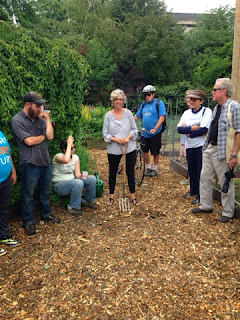Congratulations Ginkgo Organic Gardens for making 20 years happen! On Saturday the 12th of July we had our Anniversary Celebration in 3 parts.
We began with a light monsoon that threatened to put the kibosh on the whole event. Unbelievably, volunteers showed up at 9 am in raincoats, carrying coffee and even carrying the most gorgeous cupcakes imaginable. We managed to get a soggy harvest in and spent a lot of time under the shed catching up, marveling over the garden, and considering the fate of the party. As the torrent turned to a trickle Dave Snyder, veteran volunteer, and Eric Salas, co-founder of Ginkgo, took the harvest up to the pantry.
In part two, we set up a treat-feast as the exhausted clouds hung above us. The clouds must have taken pity after seeing that we would not be stopped in our festivities and we had a dry and pleasant afternoon. Treats included among others, homemade cupcakes with vegetable decals crafted from candy, a foraged berry lemonade spritzer, delicious baked goods from Gingersnap Sweets, and a watermelon carved in the most elegant and expert way I've ever seen!
Part two also gave us the opportunity to hear from the founders of the garden Jill Baldwin, Eric Salas, Ruth Milius as well as other volunteers, members of the steering committee and our Chicago Cares liaisons. I can't explain how fortunate I feel to have stood in the same circle with these people. Our founders traveled from near (Chicago) and far (Massachusetts) and the space in between to be there. Because they traveled, I have a better portrait of the garden to give when people ask how the garden has survived for 20 years.
Part three brought us to Ten Cat for beverages and Italian food. The weather cooperated and we all got to catch up. Over and over throughout the day I heard the phrase "show up". The garden is only possible because people show up every week. It took a little longer for radishes to show up because we didn't have enough water. New and old faces show up. It should be our anthem. Show Up.











































